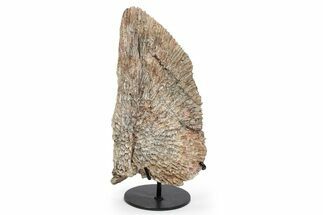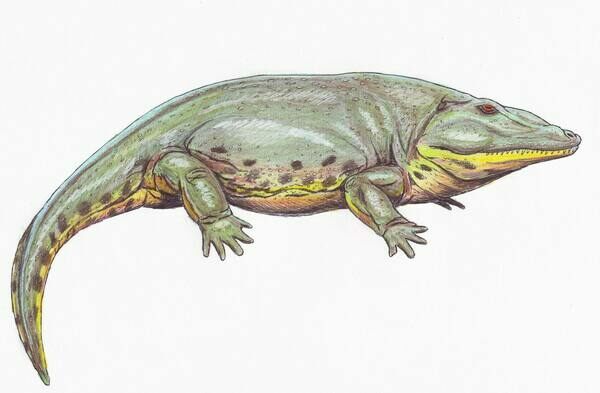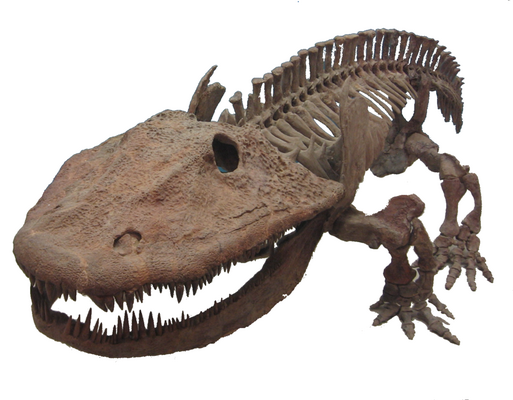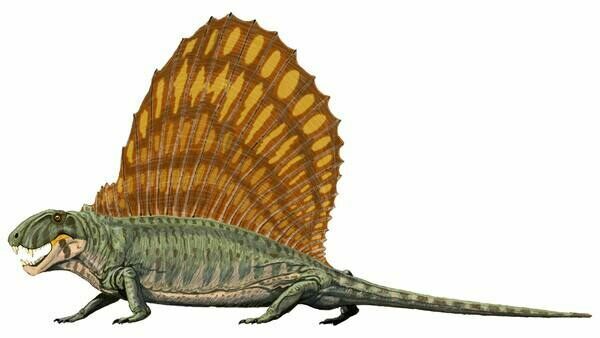This Specimen has been sold.
2.24" Permian Amphibian Or Synapsid Fossil Bone - Texas
This is a 2.24" wide bone section from a Permian animal (either Eryops, an amphibian, or Dimetrodon, a synapsid). It was collected from the Texas Red Beds Formation in Northern Texas and is approximately 280 million years old. The majority of the fossil bone material that is collected from this region of the Texas Red Beds Formation is from either Eryops or Dimetrodon. Due to the lack of identifiable bone detail, it is difficult to distinguish between the two animals and provide an accurate genus for this bone.
The most prominent feature of Dimetrodon is the large sail on its back, formed by elongated spines extending from the vertebrae. It walked on four legs and had a tall, curved skull with large teeth of different sizes set along the jaws. Most fossils have been found in the southwestern United States, the majority from a geological deposit called the Red Beds in Texas and Oklahoma.
Dimetrodon is often mistaken for a dinosaur or a contemporary of dinosaurs in popular culture, but it became extinct some 40 million years before the first appearance of dinosaurs. Reptile-like in appearance and physiology, Dimetrodon is nevertheless more closely related to mammals than to modern reptiles, though it is not a direct ancestor or descendant of mammals.
Dimetrodon is assigned to a group traditionally called "mammal-like reptiles", more recently termed "stem-mammals" or "non-mammalian synapsids". That is, many vertebrate paleontologists today group Dimetrodon together with mammals in an evolutionary group, or clade, called Synapsida, while they place dinosaurs with living reptiles and birds in a separate clade, Sauropsida. Single openings in the skull behind each eye, known as temporal fenestrae, and other skull features distinguish Dimetrodon and mammals from most of the earliest sauropsids.
Dimetrodon was probably one of the top predators in Early Permian ecosystems, feeding on fish and tetrapods, including reptiles as well as amphibians. Smaller Dimetrodon species may have had different ecological roles. Dimetrodon's sail may have been used to stabilize its spine or to heat and cool its body as a form of thermoregulation. Some recent studies argue that the sail would have been ineffective at removing heat from the body, and was most likely used in sexual display.
Eryops, maining “drawn-out face”, was a primitive amphibious temnospondyls that lived about 295 million years ago. While a handful of complete skeletons have been found, teeth are the most common fossil. Its fossils are primarily found in Texas, Oklahoma, and New Mexico.
Eryops averaged around 5 to 7 feet long, but could grow up to 10 feet, making them the largest land animals living at the time. They had a large, broad, flat skull with a large mouth and many slightly curved teeth. Its teeth had enamel with a folded pattern, leading to its early classification as a "labyrinthodont" ("maze toothed"). The shape and cross section of these teeth made them exceptionally strong and resistant to stresses. The palate, or roof of the mouth, contained three pairs of backward-curved fangs, and was covered in backward-pointing bony projections that would have been used to trap slippery prey once caught. This, coupled with the wide gape, suggest an inertial method of feeding, in which the animal would grasp its prey and thrust forward, forcing the prey farther back into its mouth.
Like other large primitive temnospondyls, Eryops would have grown slowly and gradually from aquatic larvae, but they did not go through a dramatic metamorphosis like many modern amphibians. While adults probably lived in ponds and rivers or may have ventured onto their banks, juvenile Eryops may have lived in swamps, which may have offered more shelter from predators.
Eryops averaged around 5 to 7 feet long, but could grow up to 10 feet, making them the largest land animals living at the time. They had a large, broad, flat skull with a large mouth and many slightly curved teeth. Its teeth had enamel with a folded pattern, leading to its early classification as a "labyrinthodont" ("maze toothed"). The shape and cross section of these teeth made them exceptionally strong and resistant to stresses. The palate, or roof of the mouth, contained three pairs of backward-curved fangs, and was covered in backward-pointing bony projections that would have been used to trap slippery prey once caught. This, coupled with the wide gape, suggest an inertial method of feeding, in which the animal would grasp its prey and thrust forward, forcing the prey farther back into its mouth.
Like other large primitive temnospondyls, Eryops would have grown slowly and gradually from aquatic larvae, but they did not go through a dramatic metamorphosis like many modern amphibians. While adults probably lived in ponds and rivers or may have ventured onto their banks, juvenile Eryops may have lived in swamps, which may have offered more shelter from predators.
The most prominent feature of Dimetrodon is the large sail on its back, formed by elongated spines extending from the vertebrae. It walked on four legs and had a tall, curved skull with large teeth of different sizes set along the jaws. Most fossils have been found in the southwestern United States, the majority from a geological deposit called the Red Beds in Texas and Oklahoma.
Dimetrodon is often mistaken for a dinosaur or a contemporary of dinosaurs in popular culture, but it became extinct some 40 million years before the first appearance of dinosaurs. Reptile-like in appearance and physiology, Dimetrodon is nevertheless more closely related to mammals than to modern reptiles, though it is not a direct ancestor or descendant of mammals.
Dimetrodon is assigned to a group traditionally called "mammal-like reptiles", more recently termed "stem-mammals" or "non-mammalian synapsids". That is, many vertebrate paleontologists today group Dimetrodon together with mammals in an evolutionary group, or clade, called Synapsida, while they place dinosaurs with living reptiles and birds in a separate clade, Sauropsida. Single openings in the skull behind each eye, known as temporal fenestrae, and other skull features distinguish Dimetrodon and mammals from most of the earliest sauropsids.
Dimetrodon was probably one of the top predators in Early Permian ecosystems, feeding on fish and tetrapods, including reptiles as well as amphibians. Smaller Dimetrodon species may have had different ecological roles. Dimetrodon's sail may have been used to stabilize its spine or to heat and cool its body as a form of thermoregulation. Some recent studies argue that the sail would have been ineffective at removing heat from the body, and was most likely used in sexual display.
SPECIES
Eryops sp. or Dimetrodon sp.
LOCATION
Northern Texas
FORMATION
Texas Red Beds Formation
SIZE
2.24" wide
CATEGORY
SUB CATEGORY
ITEM
#218710
We guarantee the authenticity of all of our specimens.
 Reviews
Reviews














